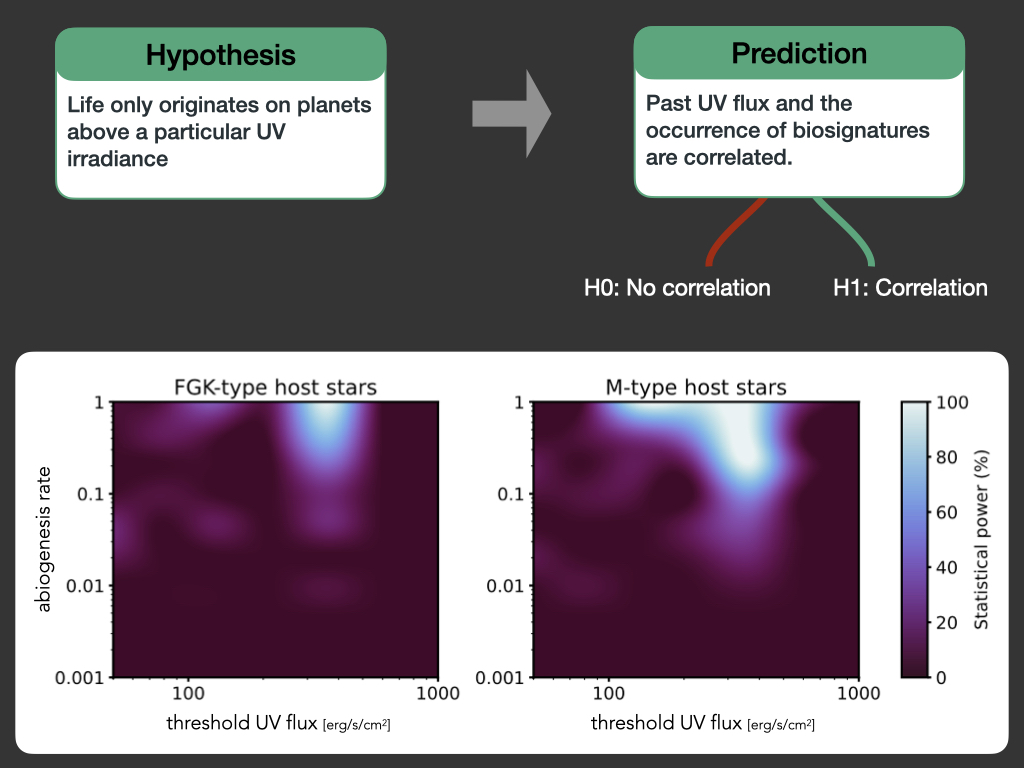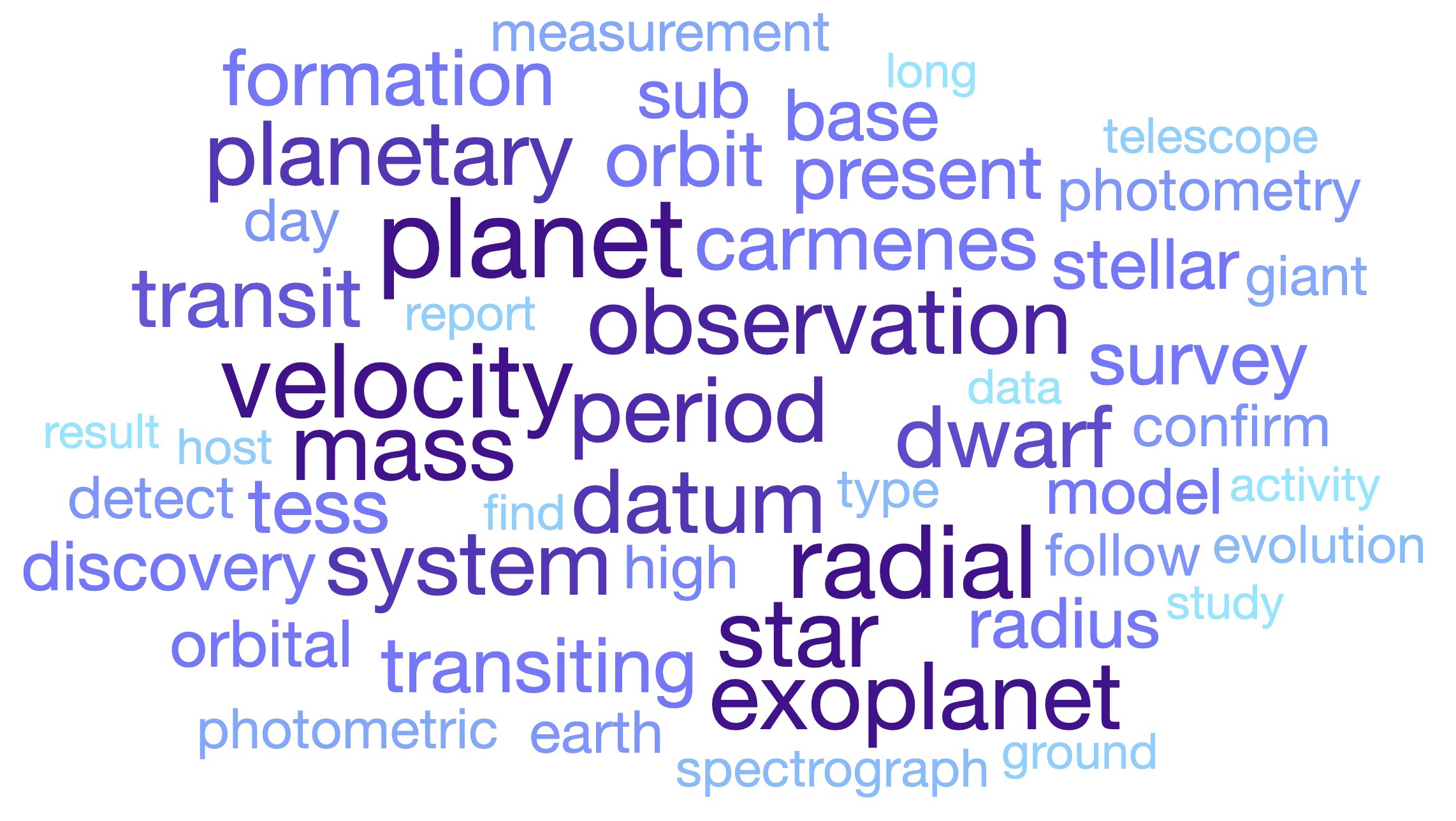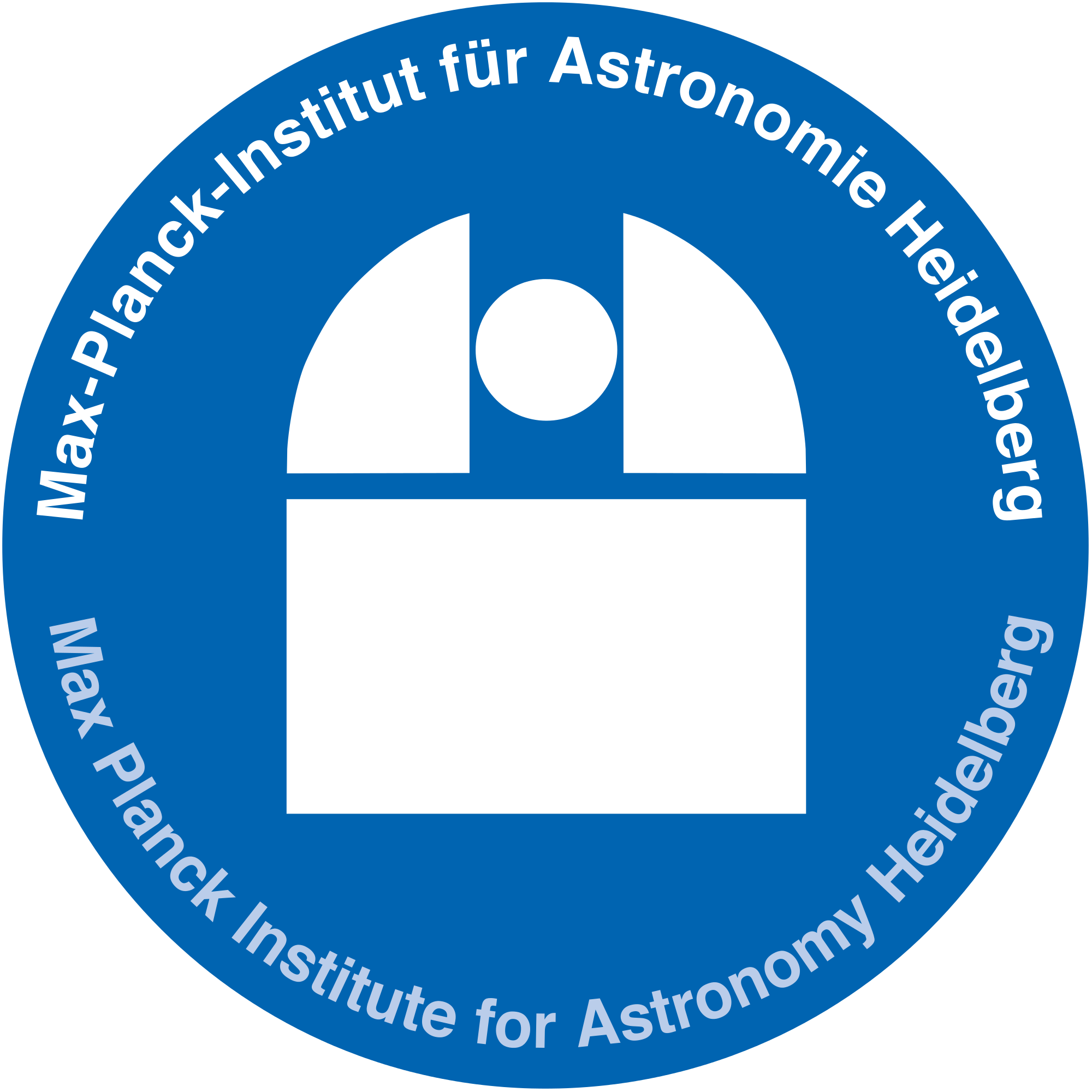
I am an astrophysicist studying the formation and habitability of planets outside the Solar System.
My research revolves around exoplanet demographics and the search for habitable worlds and life.
Since July 2025 I am an ESO Fellow at the European Southern Observatory.
Previously, I was a postdoctoral researcher at The University of Arizona.
Before that, I was at the Max Planck Institute for Astronomy and graduated from the University of Heidelberg with a PhD in astronomy.
For a very high-level overview of my work, here is a word cloud produced from the content of all my papers:

Outside the office, I enjoy paragliding, ultralight hiking, climbing, good coffee, and all things outdoors.
Research Highlights
One of the most fundamental open questions in science is whether the emergence of life is a rare accident or a predictable outcome of planetary environments. While origin-of-life theories are often framed in terms of chemistry and Earth’s history, here we treat one concrete scenario as an astrophysical hypothesis: the requirement of a minimum level of near-ultraviolet (NUV) radiation to initiate prebiotic chemistry on habitable planets.
Using the Bioverse survey simulator, we show that this UV Threshold Hypothesis — that life can only originate on planets with sufficient past NUV irradiation — predicts a distinct, observable imprint in the population-level distribution of biosignatures. We demonstrate that future biosignature surveys with observatories such as the Extremely Large Telescope, Nautilus, the Habitable Worlds Observatory, and LIFE can, in principle, distinguish origin-of-life scenarios, and we identify the sample sizes, stellar targets, and survey strategies that maximize diagnostic power.
More broadly, our work shows how population-level exoplanet surveys can be used to test competing theories for abiogenesis, shifting the focus from “Is there life?” to “Why does life arise where it does?” In doing so, it directly links astrophysical observations to the chemical and physical processes that may have led to life on Earth.
The habitable zone – a proposed region around a star where conditions support the existence of liquid water on the surface of a planet – remains a theoretical concept. Climate models predict that at its inner edge, a runaway greenhouse transition occurs that separates temperate planets and those with inflated, hot steam atmospheres.
Using our statistical hypothesis testing framework Bioverse, we predict that near-future exoplanet surveys such as PLATO will likely be able to detect this transition in the form of a discontinuity in the distribution of planet radii and densities. We determine survey strategies that maximize the scientific return of these missions and help identify the nearest habitable worlds.
Our research is fully reproducible and open source: All code required to reproduce the results, figures, and even the article itself is available online.
This exciting project is only marginally related to my research focus, but it is close to my heart. Its goal is to develop a highly scalable technological solution for removal and safe sequestration of atmospheric CO2.
Our approach involves a special species of photosynthesizing algae, called Coccolithophores, which we breed in a novel type of bioreactor. We have patented the use of this bioreactor for removing carbon dioxide, and we now optimize the design to scale up our extraction capacity. It's exciting to work together with (astro-)biologists, ecologists, and bioengineers in our highly interdisciplinary team! Learn more about our solution on Atmospherica's project homepage.

This project puts our planet formation theories to the test. After adapting our models to low-mass stars in Burn, Schlecker, et al. 2021, we compare simulated planet populations to radial velocity (RV)-detected planets around M dwarfs.
A key part of this analysis was accounting for detection biases, which we accomplished by injecting artificial planets in the real measured RV time series and trying to recover them. We found that while our models agree with the distributions of small, terrestrial planets, there is a striking discrepancy for giant planets: They have been found around the lightest stars in our sample, which our simulations cannot reproduce. There is also an interesting lack of short-period planets around the more massive host stars, which points to a - currently not well understood - planet migration trap around these stars.
As it turns out, M dwarfs are not just small Suns.
State-of-the-art planet formation models are more and more capable of accounting for the full spectrum of known planet types, but this comes at the cost of increasing model complexity. This calls into question whether established links between the initial conditions of the simulations and the calculated planetary observables are preserved.
In our paper, we take a data-driven approach to investigate such relations in a global model of planet formation and evolution. First, we used a Gaussian Mixture Model to perform a cluster analysis on typical exoplanet observables such as planet radius, mass, and orbital distance. Interestingly, the algorithm identified roughly the same planet species as the ones defined by exoplanet observations (without knowing anything about the physical model or planet demographics!).
Then, we trained a Random Forest Classifier to predict which planet type forms, given certain properties of the originating protoplanetary disk. This way, we could not only find the most predictive features of the disks, but also pinpoint the influence of gravitational interactions in multi-planet systems to specific planet types.
Schlecker et al. 2021 A&A 656, A71, also check out the press release (available in English and German) and related articles in international news outlets.
In this paper, we tested what planet formation has to say about a peculiar trend that has been found in exoplanet demographics: around solar-type stars, inner super-Earths and outer giant planets tend to occur together.
This challenges some established planet formation theories that predicted an anti-correlation of these planet types.
Our synthetic population of 1000 multi-planet systems supports the observed trend, but with important caveats.
When we associate our initial conditions with the composition of the resulting planets, we see a quite interesting link:
Depending on the initial solid mass, we either get isolated, icy super-Earths or rocky ones that have a cold Jupiter companion.
This gives rise to the testable hypothesis that high-density inner super-Earths are proxies for cold Jupiters in the same system.
A confirmation of this prediction would constrain central open questions in contemporary planet formation theory, ranging from efficiency of pebble accretion to planet migration behavior.
The orbital parameters of warm Jupiters serve as a record of their formation history, providing constraints on formation scenarios for giant planets on close and intermediate orbits. In this study with the WINE (Warm gIaNts with tEss) collaboration, we report the discovery of a new exoplanet that we detected in full frame images of the TESS space telescope and followed up with ground-based photometry (CHAT and LCOGT) and radial velocity measurements (FEROS). We precisely constrained its mass to Mp= 1.94 +/- 00.1 Mj, and its radius to Rp = 1.24 +/- 0.15 Rj.
It orbits a G-type star, similar to the Sun (Ms = 1.03 +/- 0.06 Msun, V = 12.1 mag), on one of the most eccentric orbits of all known warm giants. In fact, with a period of 15.17 d and e ≈ 0.58 its orbital parameters resemble those of the TESS spacecraft itself. This extreme dynamical state points to a past interaction with an additional, undetected massive companion. A tidal evolution analysis showed a large tidal dissipation timescale, suggesting that the planet is not a progenitor for a hot Jupiter caught during its high-eccentricity migration. This planet further represents an attractive opportunity to study the energy deposition and redistribution in the atmosphere of a warm Jupiter with high eccentricity.
The ExoEarth Discovery and Exploration Network (EDEN) transit survey is a large-scale search for transiting habitable zone Earth-sized planets around nearby stars. In contrast to most ongoing and past surveys, the EDEN team utilizes large research telescopes (0.8 m–2.4 m), which allows for efficient probing of the habitable zones of late M-dwarf stars.
During my time in Heidelberg, I led a team of 14 PhD students and post-docs that observes with one of EDEN's workhorses, the Calar Alto 1.2 m telescope. As of 2021, we contributed more than 200 full nights of observations. Being interested in planet demographics, I am also involved in EDEN's target selection and survey statistics.
I have developed and contributed to a number of open-source software packages for astronomical research. I have led or am a main developer of the following projects:
| Bioverse | Survey simulator and hypothesis testing framework for exoplanet science |
| TESSalerts | Target selection for radial velocity follow-up of planet candidates from the TESS mission |
| lcps | Pre-selecting light curves with possible transit signatures |
| Arxiv-scan | Command line tool that lists scientific literature relevant to the user |
My trajectory in science

Studied planetary habitability with Prof. Daniel Apai and the NASA-funded Alien Earths team at the Steward Observatory.

In my PhD under supervision of Prof. Thomas Henning and Prof. Hubert Klahr at the Max Planck Institute for Astronomy, I focused on the formation and architectures of planetary systems.

For my Master's project, I investigated irregular transit signatures in photometry of the Kepler space telescope.

During my Master's, I took a semester off to help perform validation tests of DLR's HP3 heat flow probe. HP3 is a major payload of NASA's InSight mission to Mars.

In my Bachelor's thesis, I characterized the optics of the X-Ray space telescope micro-ROSI, which was launched into space on the Max Valier Satellite in 2017.